Durability and Acoustic Performance of Rubberized Concrete Containing POFA as Cement Replacement
Abstract
:1. Introduction
2. Materials and Process Technology Standardization
2.1. Materials
2.2. Rubberized Concrete Mix Design
2.3. Tests Program
3. Results and Discussion
3.1. Water Absorption
3.2. Rapid Chloride Penetration Test (RCPT)
3.3. Fire Endurance
3.3.1. Effect of Temperature on Physical Properties of Concrete Containing Type R1 Rubber Aggregates
3.3.2. Residual CS of Rubberized Concrete at Elevated Temperatures
3.3.3. Impact of Temperature on the Weight Loss of Modified Rubberized Concrete
3.3.4. Ultrasonic Pulse Velocity (UPV) of Rubberized Concrete in Air-Cooling Regime
3.3.5. Effect of Elevated Temperatures on Microstructures of Modified Rubberized Concrete
3.3.6. Relationship between UPV Values and Residual Compressive Strength of Rubberized Concrete
3.4. Impedance Measurement
4. Conclusions
- The water absorption properties of the proposed rubberized concrete indicated an increase in the permeability and total porosity with the increase in rubber content in the mixture. Incorporation of coarse rubber aggregate showed a greater ability to increase the permeability properties of the rubberized concrete than fine rubber particles;
- A rapid chloride ion penetration result revealed that the studied rubberized concrete was satisfactory. Nevertheless, incorporation of rubber aggregates was found to increase chloride penetration, which was more pronounced in coarse rubber aggregate-included concrete. Generally, rubberized concrete was classified as achieving a low to moderate level of chloride penetration, following the ASTM standard;
- The elevated temperatures had significant effects on the performance of rubberized concrete wherein the post-fire properties of concrete made with rubber particles was considerably affected. The rubberized concrete showed satisfactory performance up to 500 °C, wherein all types of rubber concrete effectively lost performance at 800 °C. A visual inspection revealed that concrete made with rubber particles was greatly influenced by rubber aggregate content, wherein concrete with higher amounts of rubber particles displayed more carbon black. With the increase in temperatures, the residual compressive strength of the rubberized concrete revealed a progressive deterioration. In addition, the UPV values decreased in line with the compressive strength;
- A systematic improvement of NRC was achieved by increasing the rubber content, useful for the development of sound-proof concrete material required for various low-cost structural applications. It was asserted that the present study may provide higher standards of residential buildings in the provision of quiet spaces;
- Coarse rubber aggregates were found to be the best NCR among the three types of rubber particles;
- In short, the proposed rubberized concrete containing POFA as cement replacement can be a potential candidate in the construction industry owing to its excellent durability and acoustic performance, thus, minimizing landfill and environmental problems.
Author Contributions
Funding
Institutional Review Board Statement
Informed Consent Statement
Data Availability Statement
Conflicts of Interest
References
- Thomas, B.S.; Gupta, R.C.; Panicker, V.J. Recycling of waste tire rubber as aggregate in concrete: Durability-related performance. J. Clean. Prod. 2016, 112, 504–513. [Google Scholar] [CrossRef]
- Thomas, B.S.; Gupta, R.C. A comprehensive review on the applications of waste tire rubber in cement concrete. Renew. Sustain. Energy Rev. 2016, 54, 1323–1333. [Google Scholar] [CrossRef]
- Rashid, K.; Yazdanbakhsh, A.; Rehman, M.U. Sustainable selection of the concrete incorporating recycled tire aggregate to be used as medium to low strength material. J. Clean. Prod. 2019, 224, 396–410. [Google Scholar] [CrossRef]
- Ferronato, N.; Torretta, V. Waste mismanagement in developing countries: A review of global issues. Int. J. Environ. Res. Public Health 2019, 16, 1060. [Google Scholar] [CrossRef] [Green Version]
- Mhaya, A.M.; Baghban, M.H.; Faridmehr, I.; Huseien, G.F.; Abidin, A.R.Z.; Ismail, M. Performance evaluation of modified rubberized concrete exposed to aggressive environments. Materials 2021, 14, 1900. [Google Scholar] [CrossRef] [PubMed]
- Brown, K.M.; Cummings, R.; Mrozek, J.R.; Terrebonne, P. Scrap tire disposal: Three principles for policy choice. Nat. Resour. J. 2001, 41, 9–22. [Google Scholar]
- Akbas, A.; Yuhana, N.Y. Recycling of Rubber Wastes as Fuel and Its Additives. Recycling 2021, 6, 78. [Google Scholar] [CrossRef]
- Sienkiewicz, M.; Janik, H.; Borzędowska-Labuda, K.; Kucińska-Lipka, J. Environmentally friendly polymer-rubber composites obtained from waste tyres: A review. J. Clean. Prod. 2017, 147, 560–571. [Google Scholar] [CrossRef]
- Shakya, P.R.; Shrestha, P.; Tamrakar, C.S.; Bhattarai, P.K. Studies on potential emission of hazardous gases due to uncontrolled open-air burning of waste vehicle tyres and their possible impacts on the environment. Atmos. Environ. 2008, 42, 6555–6559. [Google Scholar] [CrossRef]
- De Brito, J.; Saikia, N. Recycled Aggregate in Concrete: Use of Industrial, Construction and Demolition Waste; Springer Science & Business Media: Berlin/Heidelberg, Germany, 2012; pp. 156–216. [Google Scholar]
- Ahmad, J.; Zhou, Z.; Majdi, A.; Alqurashi, M.; Deifalla, A.F. Overview of Concrete Performance Made with Waste Rubber Tires: A Step toward Sustainable Concrete. Materials 2022, 15, 5518. [Google Scholar] [CrossRef]
- Association, R.M. US Scrap Tire Management Summary; Rubber Manufacturers Association: Washington, DC, USA, 2014. [Google Scholar]
- Association, R.M. Scrap tire markets in the United States. 9th Bienn. Rep. 2009, 5, 1–105. [Google Scholar]
- Mhaya, A.; Abidin, A.; Sarbini, N.; Ismail, M. Role of crumb tyre aggregates in rubberised concrete contained granulated blast-furnace slag. IOP Conf. Ser. Earth Environ. Sci. 2019, 220, 012029. [Google Scholar] [CrossRef]
- Ross, D.E. Use of waste tyres in a circular economy. Waste Manag. Res. 2020, 38, 1–3. [Google Scholar] [CrossRef] [PubMed] [Green Version]
- Rubber Manufacturers Association. Scrap Tire Markets in the United States, 2005 ed.; Rubber Manufacturers Association: Washindton, DC, USA, 2006; Volume 12. [Google Scholar]
- Qaidi, S.M.; Mohammed, A.S.; Ahmed, H.U.; Faraj, R.H.; Emad, W.; Tayeh, B.A.; Althoey, F.; Zaid, O.; Sor, N.H. Rubberized geopolymer composites: A comprehensive review. Ceram. Int. 2022, 48, 24234–24259. [Google Scholar] [CrossRef]
- Eldin, N.N.; Senouci, A.B. Rubber-tire particles as concrete aggregate. J. Mater. Civ. Eng. 1993, 5, 478–496. [Google Scholar] [CrossRef]
- Li, G.; Stubblefield, M.A.; Garrick, G.; Eggers, J.; Abadie, C.; Huang, B. Development of waste tire modified concrete. Cem. Concr. Res. 2004, 34, 2283–2289. [Google Scholar] [CrossRef]
- Snelson, D.; Kinuthia, J.; Davies, P.; Chang, S.-R. Sustainable construction: Composite use of tyres and ash in concrete. Waste Manag. 2009, 29, 360–367. [Google Scholar] [CrossRef] [PubMed]
- Mhaya, A.M.; Fahim Huseien, G.; Faridmehr, I.; Razin Zainal Abidin, A.; Alyousef, R.; Ismail, M. Evaluating mechanical properties and impact resistance of modified concrete containing ground Blast Furnace slag and discarded rubber tire crumbs. Constr. Build. Mater. 2021, 295, 123603. [Google Scholar] [CrossRef]
- Kundan, P.; Sharma, S. Rubberized cemented concrete composites: A review. Mater. Today: Proc. 2021, 44, 4838–4842. [Google Scholar] [CrossRef]
- Roychand, R.; Gravina, R.J.; Zhuge, Y.; Ma, X.; Youssf, O.; Mills, J.E. A comprehensive review on the mechanical properties of waste tire rubber concrete. Constr. Build. Mater. 2020, 237, 117651. [Google Scholar] [CrossRef]
- Siddika, A.; Al Mamun, M.A.; Alyousef, R.; Amran, Y.M.; Aslani, F.; Alabduljabbar, H. Properties and utilizations of waste tire rubber in concrete: A review. Constr. Build. Mater. 2019, 224, 711–731. [Google Scholar] [CrossRef]
- Mhaya, A.M.; Baharom, S.; Huseien, G.F. Improved strength performance of rubberized Concrete: Role of ground blast furnace slag and waste glass bottle nanoparticles amalgamation. Constr. Build. Mater. 2022, 342, 128073. [Google Scholar] [CrossRef]
- Imbabi, M.S.; Carrigan, C.; McKenna, S. Trends and developments in green cement and concrete technology. Int. J. Sustain. Built Environ. 2012, 1, 194–216. [Google Scholar] [CrossRef] [Green Version]
- Samadi, M.; Baghban, M.H.; Kubba, Z.; Faridmehr, I.; Abdul Shukor Lim, N.H.; Benjeddou, O.; Ariffin, N.F.B.; Huseien, G.F. Flexural Behavior of Reinforced Concrete Beams under Instantaneous Loading: Effects of Recycled Ceramic as Cement and Aggregates Replacement. Buildings 2022, 12, 439. [Google Scholar] [CrossRef]
- Mhaya, A.M.; Huseien, G.F.; Abidin, A.R.Z.; Ismail, M. Long-term mechanical and durable properties of waste tires rubber crumbs replaced GBFS modified concretes. Constr. Build. Mater. 2020, 256, 119505. [Google Scholar] [CrossRef]
- Hamzah, H.K.; Joudah, Z.H.; Georgescu, D.P.; Khalid, N.H.A.; Huseien, G.F. Laboratory evaluation of alkali-activated mortars modified with nanosilica from glass bottle wastes. Mater. Today Proc. 2021, 46, 2098–2104. [Google Scholar] [CrossRef]
- Rafieizonooz, M.; Salim, M.R.; Mirza, J.; Hussin, M.W.; Khan, R.; Khankhaje, E. Toxicity characteristics and durability of concrete containing coal ash as substitute for cement and river sand. Constr. Build. Mater. 2017, 143, 234–246. [Google Scholar] [CrossRef]
- Nurfarhanna, A.; Hani, A.S.; Hairi, O.M.; Zalipah, J.; Azlina, A.N.; Norhafizah, S.; Anizahyati, A. The Compressive Strength and Water Absorption of Railway’s Concrete Sleepers Containing Palm Oil Fuel Ash (POFA) as a Cement Replacement Material. IOP Conf. Ser. Mater. Sci. Eng. 2021, 1200, 012001. [Google Scholar] [CrossRef]
- Huseien, G.F.; Sam, A.R.M.; Algaifi, H.A.; Alyouef, R. Development of a sustainable concrete incorporated with effective microorganism and fly Ash: Characteristics and modeling studies. Constr. Build. Mater. 2021, 285, 122899. [Google Scholar] [CrossRef]
- Alaskar, A.; Shah, S.; Keerio, M.A.; Phulpoto, J.A.; Baharom, S.; Assilzadeh, H.; Alyousef, R.; Alabduljabbar, H.; Mohamed, A.M. Development of Pozzolanic material from clay. Adv. Concr. Constr. 2020, 10, 301–310. [Google Scholar]
- Huseien, G.F.; Sam, A.R.M.; Shah, K.W.; Mirza, J. Effects of ceramic tile powder waste on properties of self-compacted alkali-activated concrete. Constr. Build. Mater. 2020, 236, 117574. [Google Scholar] [CrossRef]
- Huseien, G.; Ismail, M.; Tahir, M.; Mirza, J.; Hussein, A.; Khalid, N.; Sarbini, N. Performance of sustainable alkali activated mortars containing solid waste ceramic powder. Chem. Eng. Trans. 2018, 63, 673–678. [Google Scholar]
- Salman, N.M.; Ma, G.; Ijaz, N.; Wang, L. Importance and potential of cellulosic materials and derivatives in extrusion-based 3D concrete printing (3DCP): Prospects and challenges. Constr. Build. Mater. 2021, 291, 123281. [Google Scholar] [CrossRef]
- Shafigh, P.; Mahmud, H.B.; Jumaat, M.Z.; Zargar, M. Agricultural wastes as aggregate in concrete mixtures—A review. Constr. Build. Mater. 2014, 53, 110–117. [Google Scholar] [CrossRef]
- Huseien, G.F.; Ismail, M.; Tahir, M.M.; Mirza, J.; Khalid, N.H.A.; Asaad, M.A.; Husein, A.A.; Sarbini, N.N. Synergism between palm oil fuel ash and slag: Production of environmental-friendly alkali activated mortars with enhanced properties. Constr. Build. Mater. 2018, 170, 235–244. [Google Scholar] [CrossRef]
- Mhaya, A.M.; Algaifi, H.A.; Shahidan, S.; Zuki, S.S.M.; Azmi, M.A.M.; Ibrahim, M.H.W.; Huseien, G.F. Systematic Evaluation of Permeability of Concrete Incorporating Coconut Shell as Replacement of Fine Aggregate. Materials 2022, 15, 7944. [Google Scholar] [CrossRef]
- Tangchirapat, W.; Jaturapitakkul, C.; Chindaprasirt, P. Use of palm oil fuel ash as a supplementary cementitious material for producing high-strength concrete. Constr. Build. Mater. 2009, 23, 2641–2646. [Google Scholar] [CrossRef]
- Abdullah, R.; Wahid, M.B. World Palm Oil Supply, Demand, Price and Prospects: Focus on Malaysian and Indonesian Palm Oil Industry; Malaysian Palm Oil Board Press: Petaling Jaya, Malaysia, 2010. [Google Scholar]
- Sata, V.; Jaturapitakkul, C.; Kiattikomol, K. Utilization of Palm Oil Fuel Ash in High-Strength Concrete. J. Mater. Civ. Eng. 2004, 16, 623–628. [Google Scholar] [CrossRef]
- Rukzon, S.; Chindaprasirt, P. An experimental investigation of the carbonation of blended portland cement palm oil fuel ash mortar in an indoor environment. Indoor Built Environ. 2009, 18, 313–318. [Google Scholar] [CrossRef]
- Mhaya, A.M.; Baharom, S.; Baghban, M.H.; Nehdi, M.L.; Faridmehr, I.; Huseien, G.F.; Algaifi, H.A.; Ismail, M. Systematic Experimental Assessment of POFA Concrete Incorporating Waste Tire Rubber Aggregate. Polymers 2022, 14, 2294. [Google Scholar] [CrossRef]
- Santhosh, K.G.; Subhani, S.M.; Bahurudeen, A. Recycling of palm oil fuel ash and rice husk ash in the cleaner production of concrete-A review. J. Clean. Prod. 2022, 354, 131736. [Google Scholar] [CrossRef]
- Ali, N.; Sobri, M.H.A.M.; Hadipramana, J.; Samad, A.A.A.; Mohamad, N. Potential Mixture of POFA and SCBA as Cement Replacement in Concrete–A Review. MATEC Web Conf. 2017, 103, 01006. [Google Scholar] [CrossRef]
- Alsubari, B.; Shafigh, P.; Jumaat, M.Z. Utilization of high-volume treated palm oil fuel ash to produce sustainable self-compacting concrete. J. Clean. Prod. 2016, 137, 982–996. [Google Scholar] [CrossRef]
- Hamada, H.M.; Jokhio, G.A.; Yahaya, F.M.; Humada, A.M.; Gul, Y. The present state of the use of palm oil fuel ash (POFA) in concrete. Constr. Build. Mater. 2018, 175, 26–40. [Google Scholar] [CrossRef]
- Ren, F.; Mo, J.; Wang, Q.; Ho, J.C.M. Crumb rubber as partial replacement for fine aggregate in concrete: An overview. Constr. Build. Mater. 2022, 343, 128049. [Google Scholar] [CrossRef]
- Marques, A.; Correia, J.; De Brito, J. Post-fire residual mechanical properties of concrete made with recycled rubber aggregate. Fire Saf. J. 2013, 58, 49–57. [Google Scholar] [CrossRef]
- Al-Mutairi, N.; Al-Rukaibi, F.; Bufarsan, A. Effect of microsilica addition on compressive strength of rubberized concrete at elevated temperatures. J. Mater. Cycles Waste Manag. 2010, 12, 41–49. [Google Scholar] [CrossRef]
- Bravo, M.; de Brito, J. Concrete made with used tyre aggregate: Durability-related performance. J. Clean. Prod. 2012, 25, 42–50. [Google Scholar] [CrossRef]
- Ganjian, E.; Khorami, M.; Maghsoudi, A.A. Scrap-tyre-rubber replacement for aggregate and filler in concrete. Constr. Build. Mater. 2009, 23, 1828–1836. [Google Scholar] [CrossRef]
- Gesoğlu, M.; Güneyisi, E. Permeability properties of self-compacting rubberized concretes. Constr. Build. Mater. 2011, 25, 3319–3326. [Google Scholar] [CrossRef]
- ASTM, C33; Standard Specification for Concrete Aggregates. American Society for Testing and Materials: Philadelphia, PA, USA, 2003.
- Altwair, N.M.; Johari, M.M.; Hashim, S.F.S. Influence of treated palm oil fuel ash on compressive properties and chloride resistance of engineered cementitious composites. Mater. Struct. 2014, 47, 667–682. [Google Scholar] [CrossRef]
- Baghban, M.H.; Mhaya, A.M.; Faridmehr, I.; Huseien, G.F. Carbonation Depth and Chloride Ion Penetration Properties of Rubberised Concrete Incorporated Ground Blast Furnace Slag. In Solid State Phenomena; Trans Tech Publications Ltd.: Bäch, Switzerland, 2022. [Google Scholar]
- Ismail, M.; Ismail, M.E.; Muhammad, B. Influence of elevated temperatures on physical and compressive strength properties of concrete containing palm oil fuel ash. Constr. Build. Mater. 2011, 25, 2358–2364. [Google Scholar] [CrossRef]
- Demirel, B.; Keleştemur, O. Effect of elevated temperature on the mechanical properties of concrete produced with finely ground pumice and silica fume. Fire Saf. J. 2010, 45, 385–391. [Google Scholar] [CrossRef] [Green Version]
- Neville, A. Properties of Concrete, Pearson Education Limited. Edinb. Gate Harlow Engl. 2011, 6, 58–661. [Google Scholar]
- Li, L.-J.; Xie, W.-F.; Liu, F.; Guo, Y.-C.; Deng, J. Fire performance of high-strength concrete reinforced with recycled rubber particles. Mag. Concr. Res. 2011, 63, 187–195. [Google Scholar] [CrossRef]
- Handoo, S.; Agarwal, S.; Agarwal, S. Physicochemical, mineralogical, and morphological characteristics of concrete exposed to elevated temperatures. Cem. Concr. Res. 2002, 32, 1009–1018. [Google Scholar] [CrossRef]
- Janotka, I.; Nürnbergerová, T. Effect of temperature on structural quality of the cement paste and high-strength concrete with silica fume. Nucl. Eng. Des. 2005, 235, 2019–2032. [Google Scholar] [CrossRef]
- Savva, A.; Manita, P.; Sideris, K. Influence of elevated temperatures on the mechanical properties of blended cement concretes prepared with limestone and siliceous aggregates. Cem. Concr. Compos. 2005, 27, 239–248. [Google Scholar] [CrossRef]
- Yang, H.; Lin, Y.; Hsiao, C.; Liu, J.-Y. Evaluating residual compressive strength of concrete at elevated temperatures using ultrasonic pulse velocity. Fire Saf. J. 2009, 44, 121–130. [Google Scholar] [CrossRef]
- Huseien, G.F.; Sam, A.R.M.; Mirza, J.; Tahir, M.M.; Asaad, M.A.; Ismail, M.; Shah, K.W. Waste ceramic powder incorporated alkali activated mortars exposed to elevated Temperatures: Performance evaluation. Constr. Build. Mater. 2018, 187, 307–317. [Google Scholar] [CrossRef]
- Mohammed, B.S.; Hossain, K.M.A.; Swee, J.T.E.; Wong, G.; Abdullahi, M. Properties of crumb rubber hollow concrete block. J. Clean. Prod. 2012, 23, 57–67. [Google Scholar] [CrossRef]
- Sukontasukkul, P. Use of crumb rubber to improve thermal and sound properties of pre-cast concrete panel. Constr. Build. Mater. 2009, 23, 1084–1092. [Google Scholar] [CrossRef]
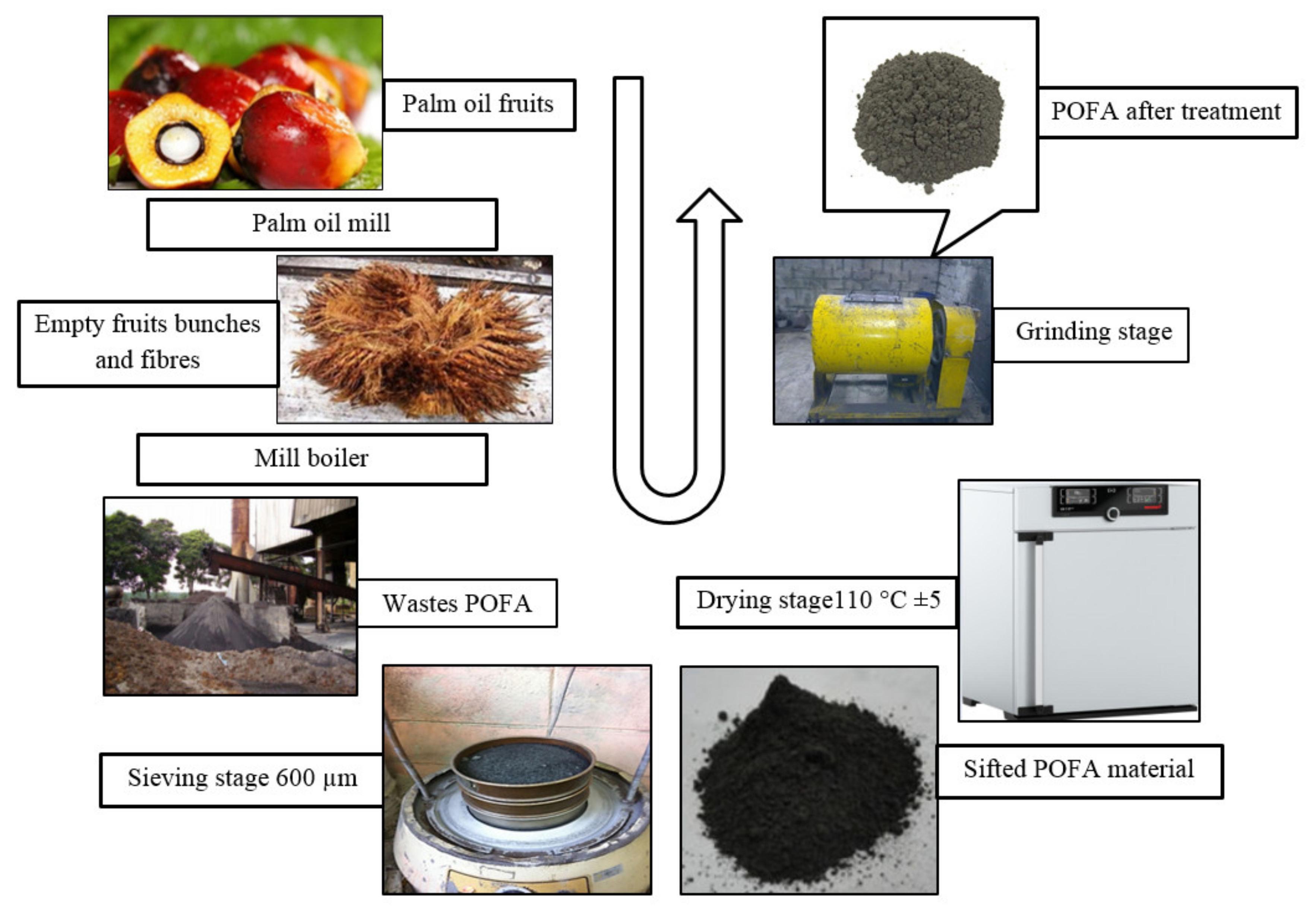
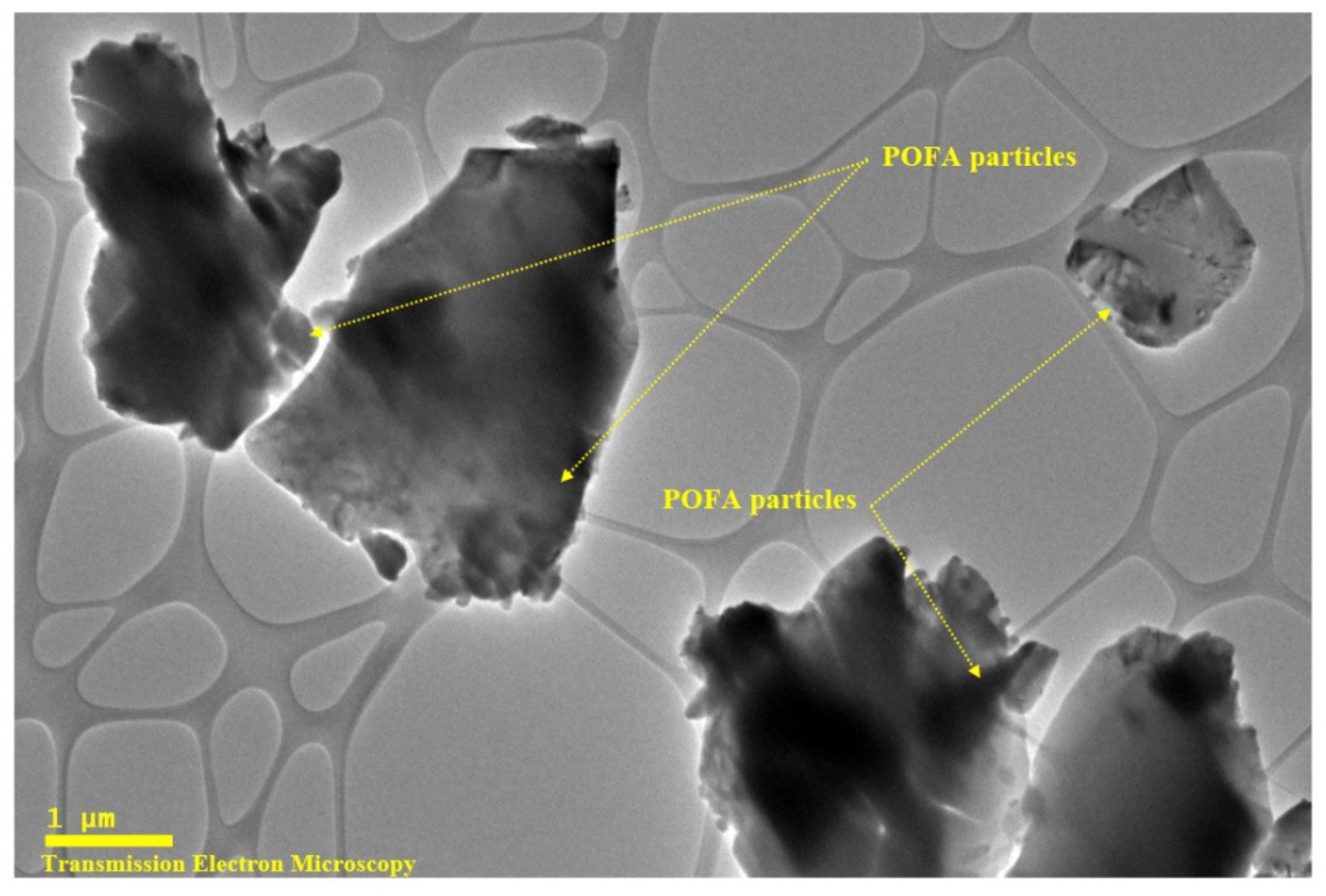
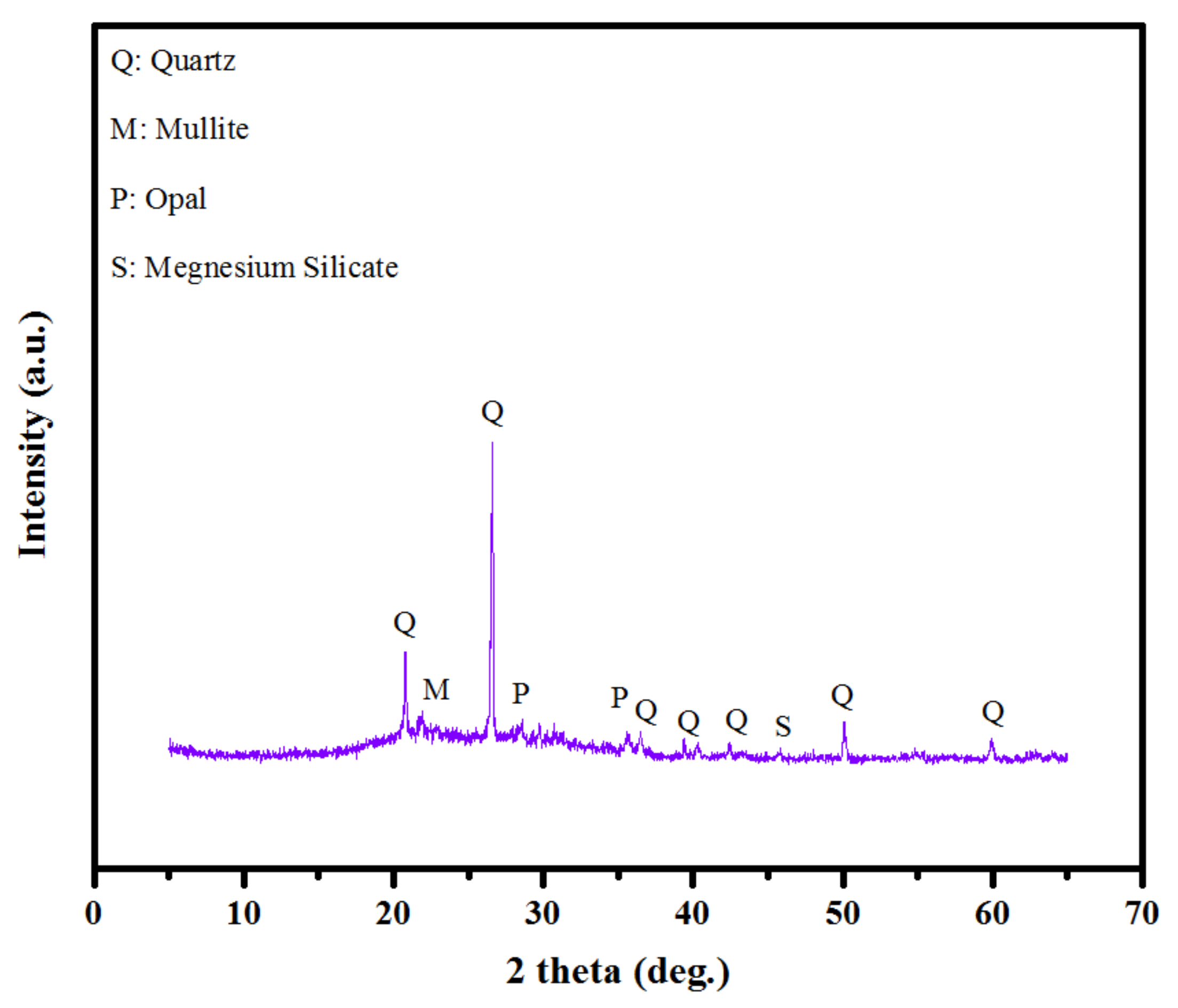


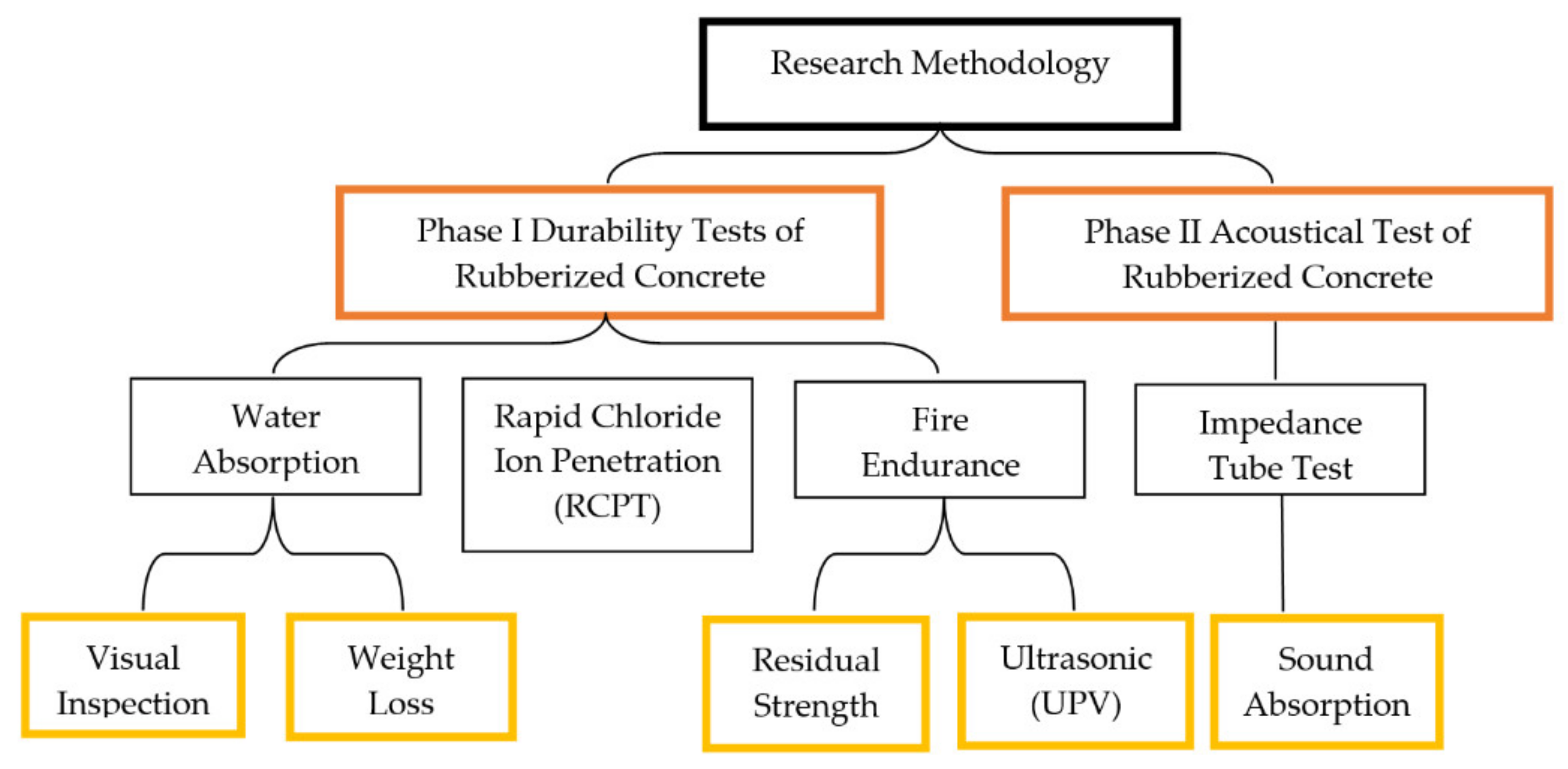
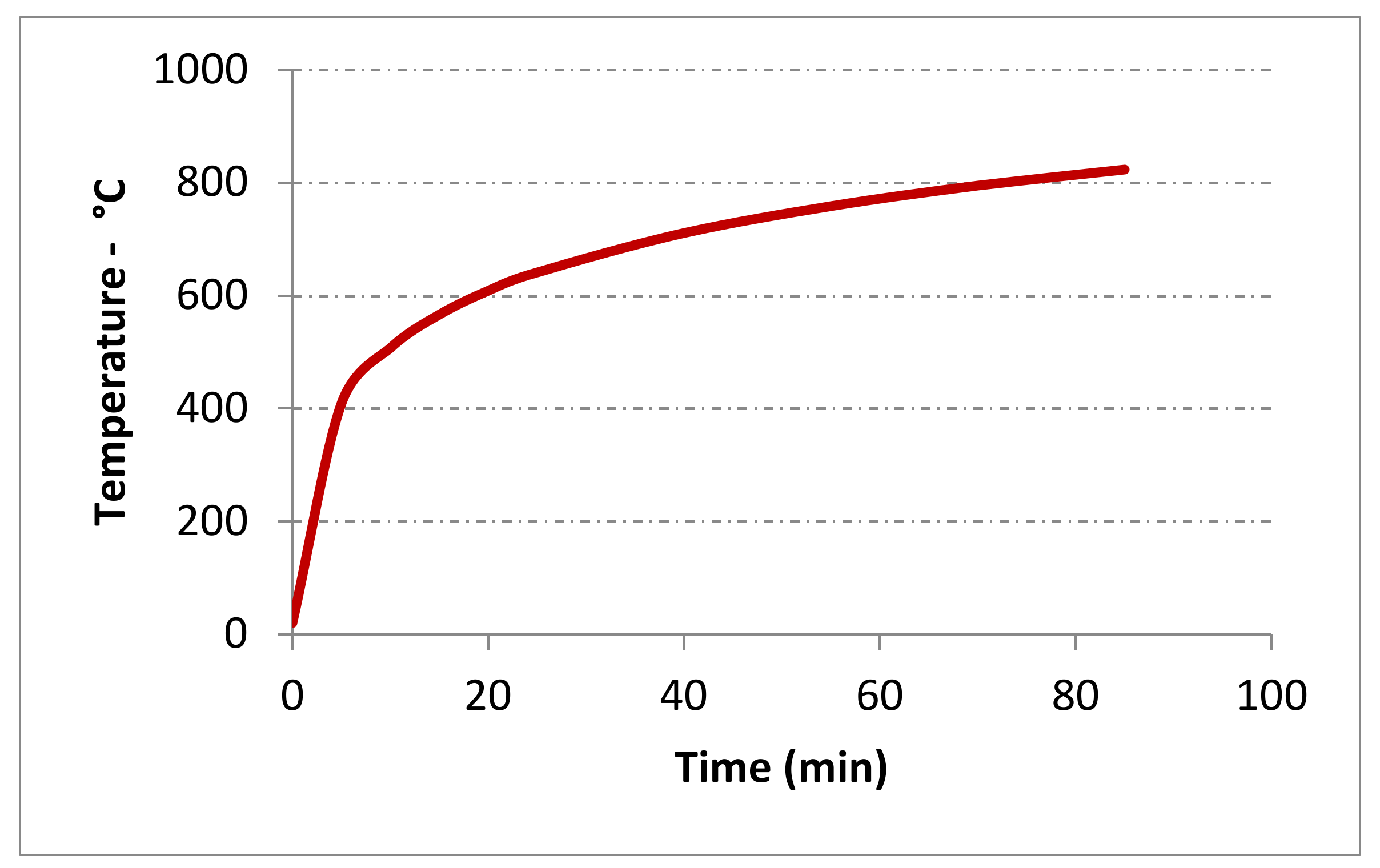

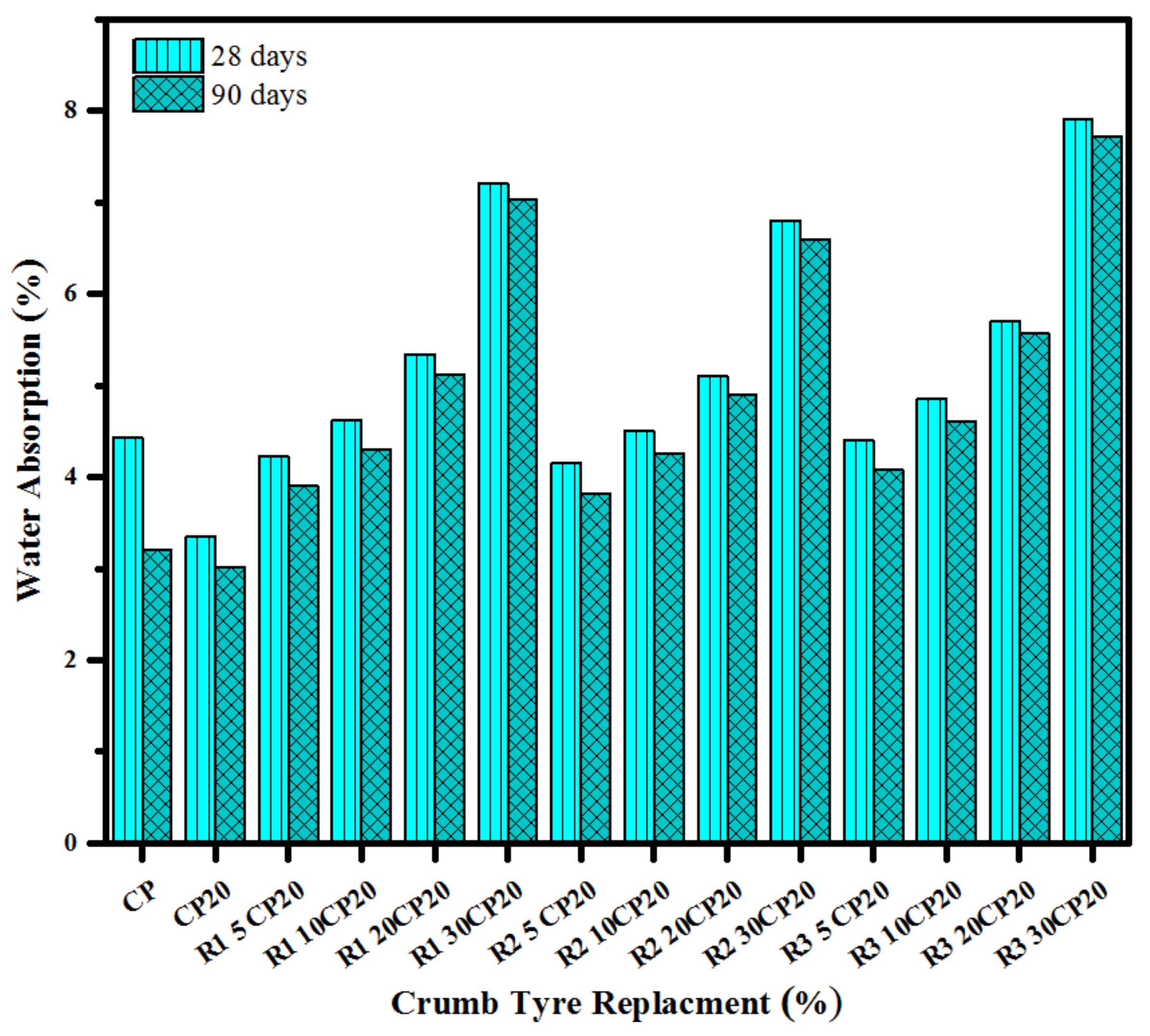
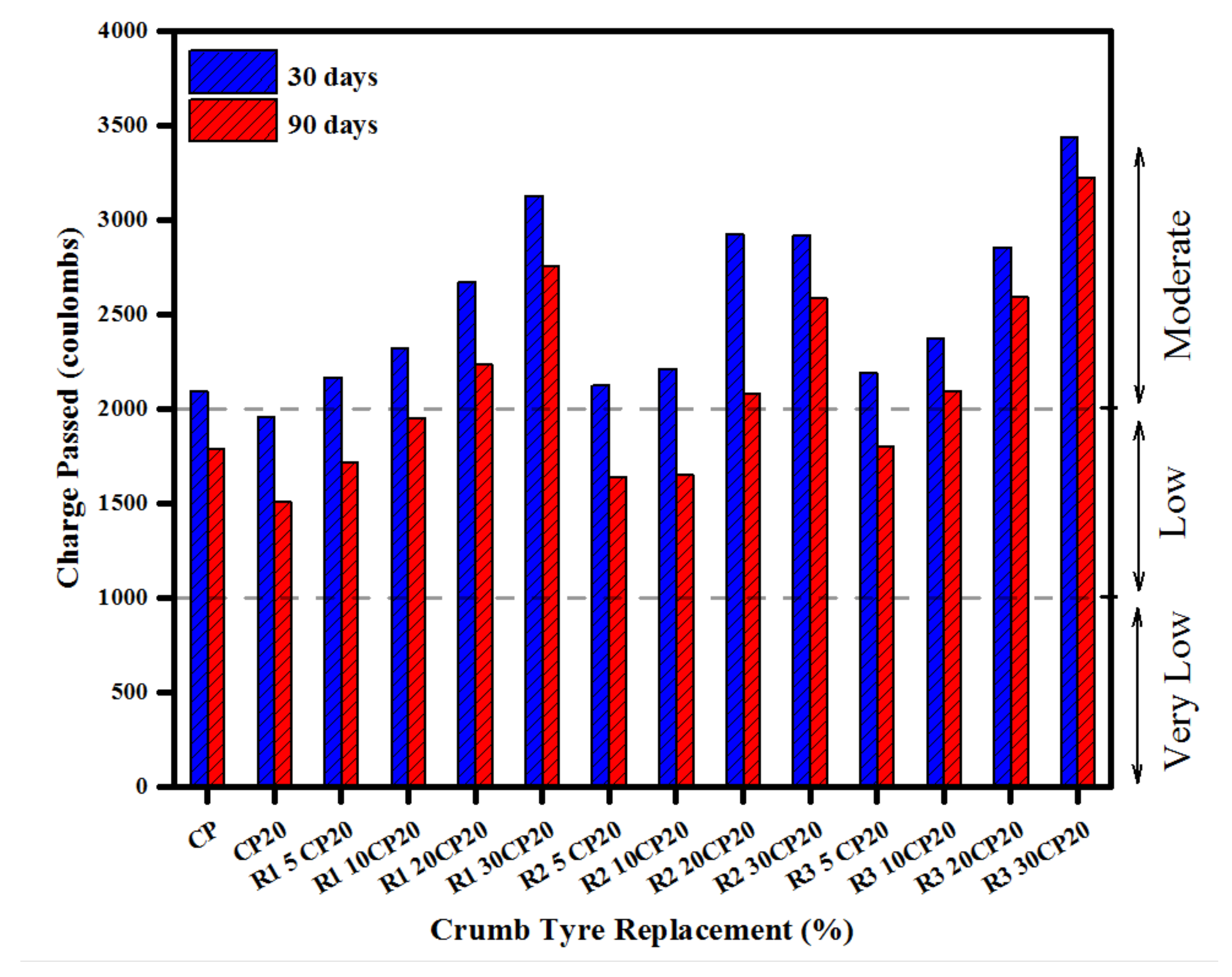

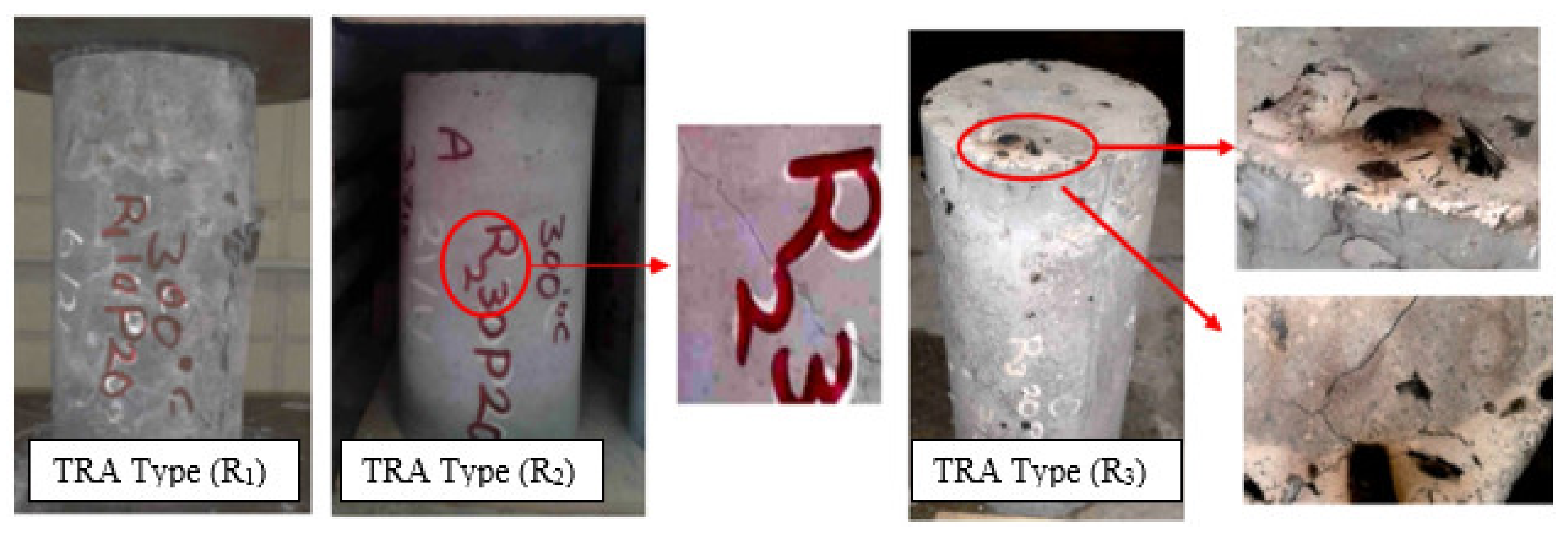

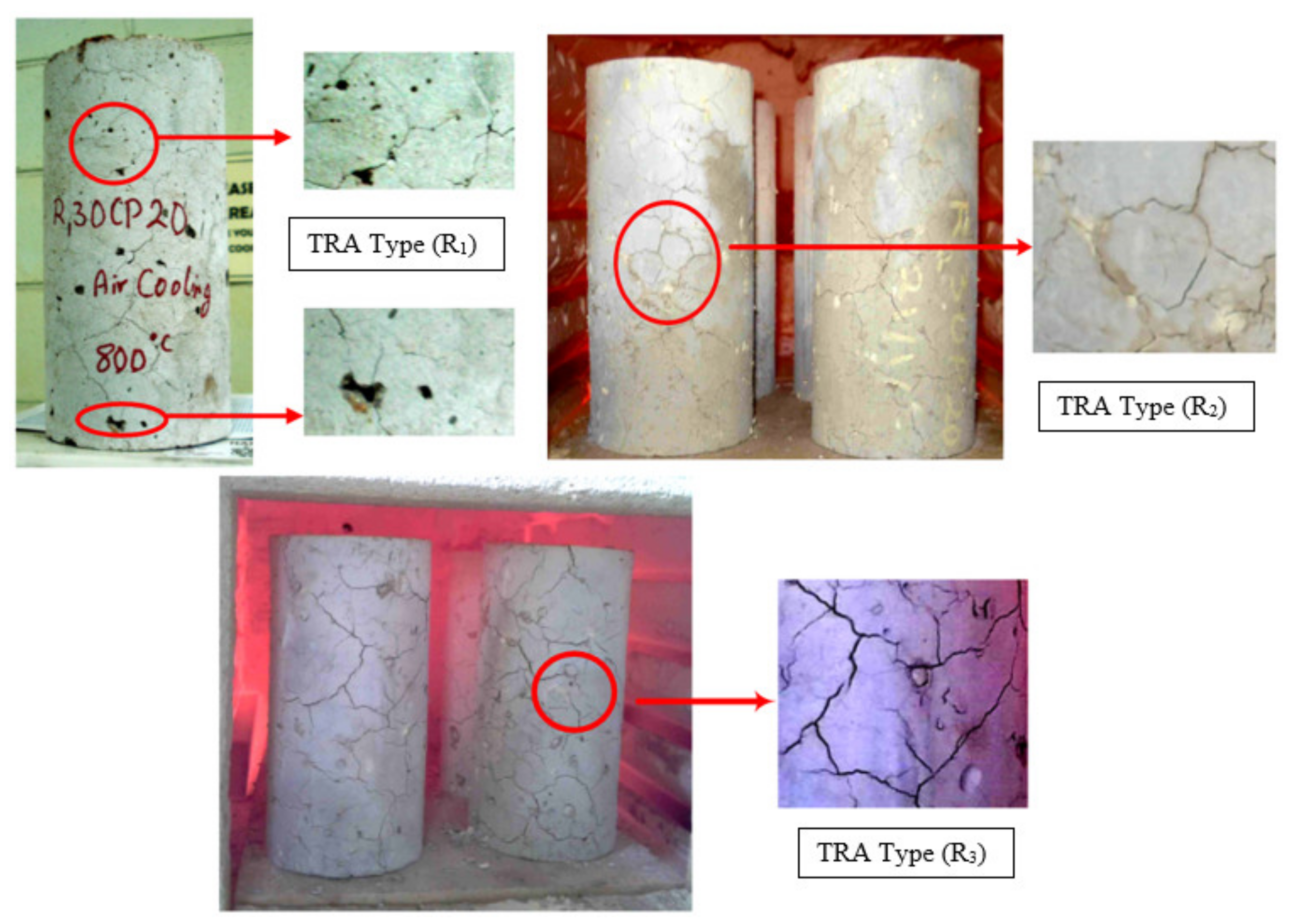
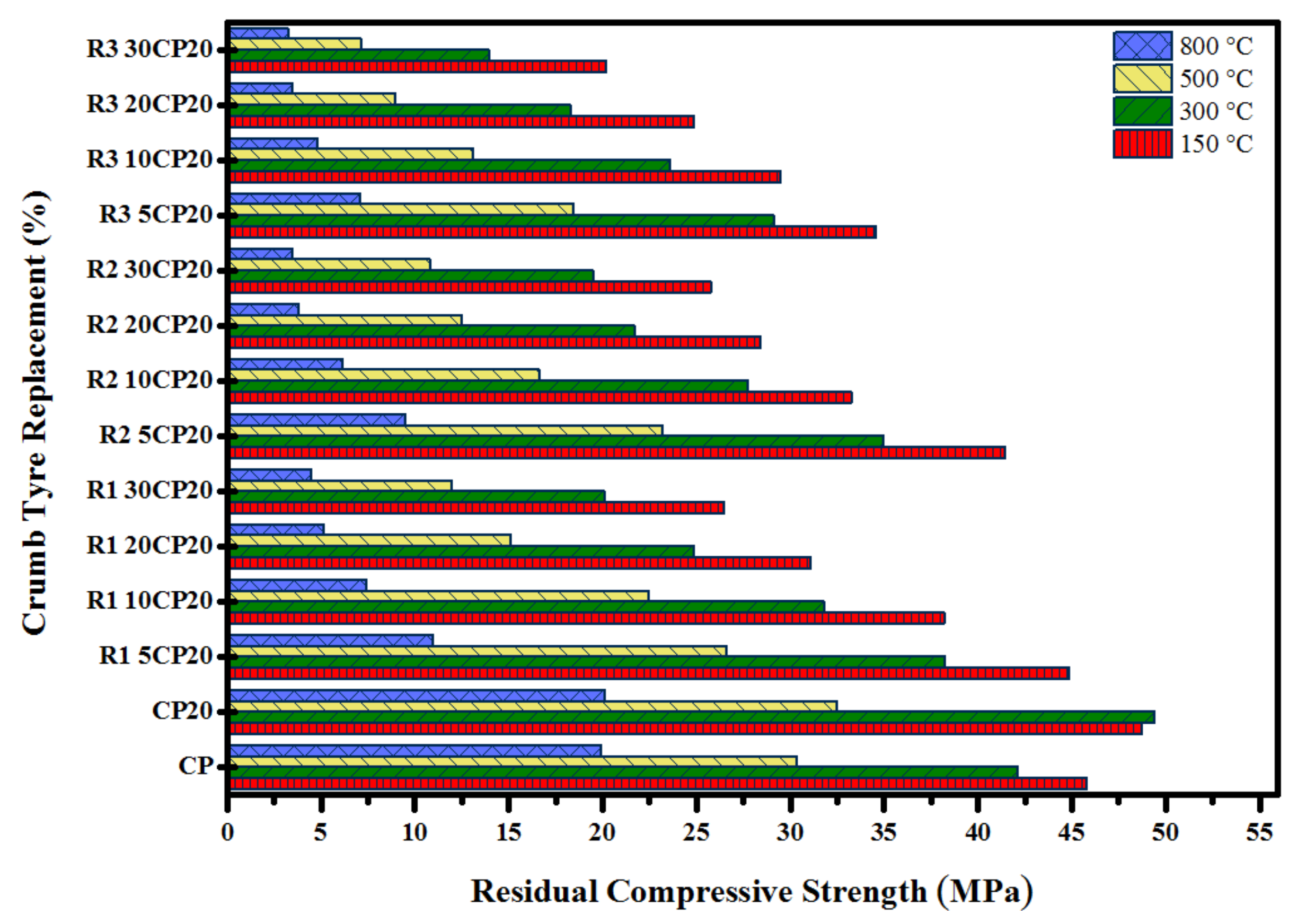
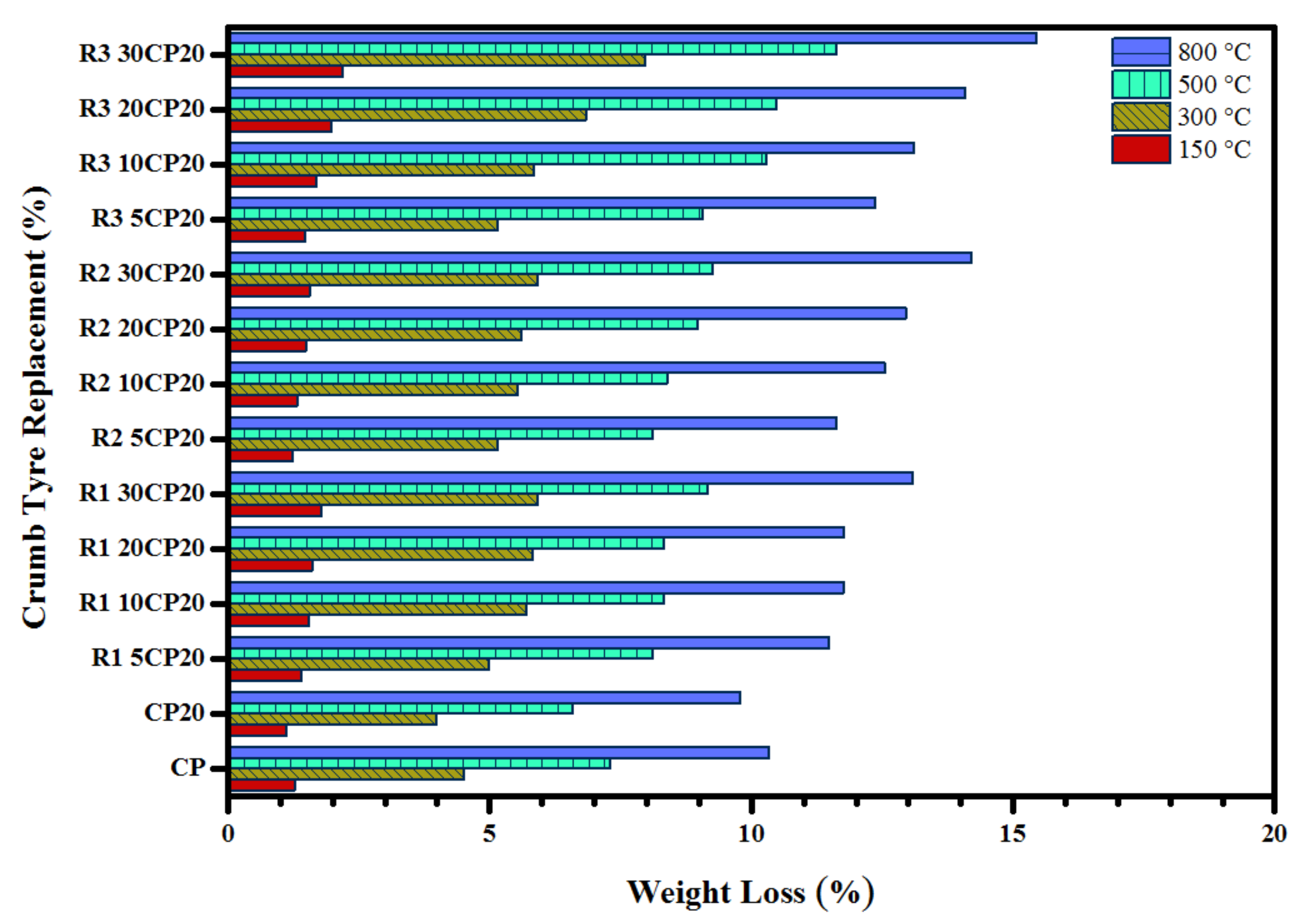
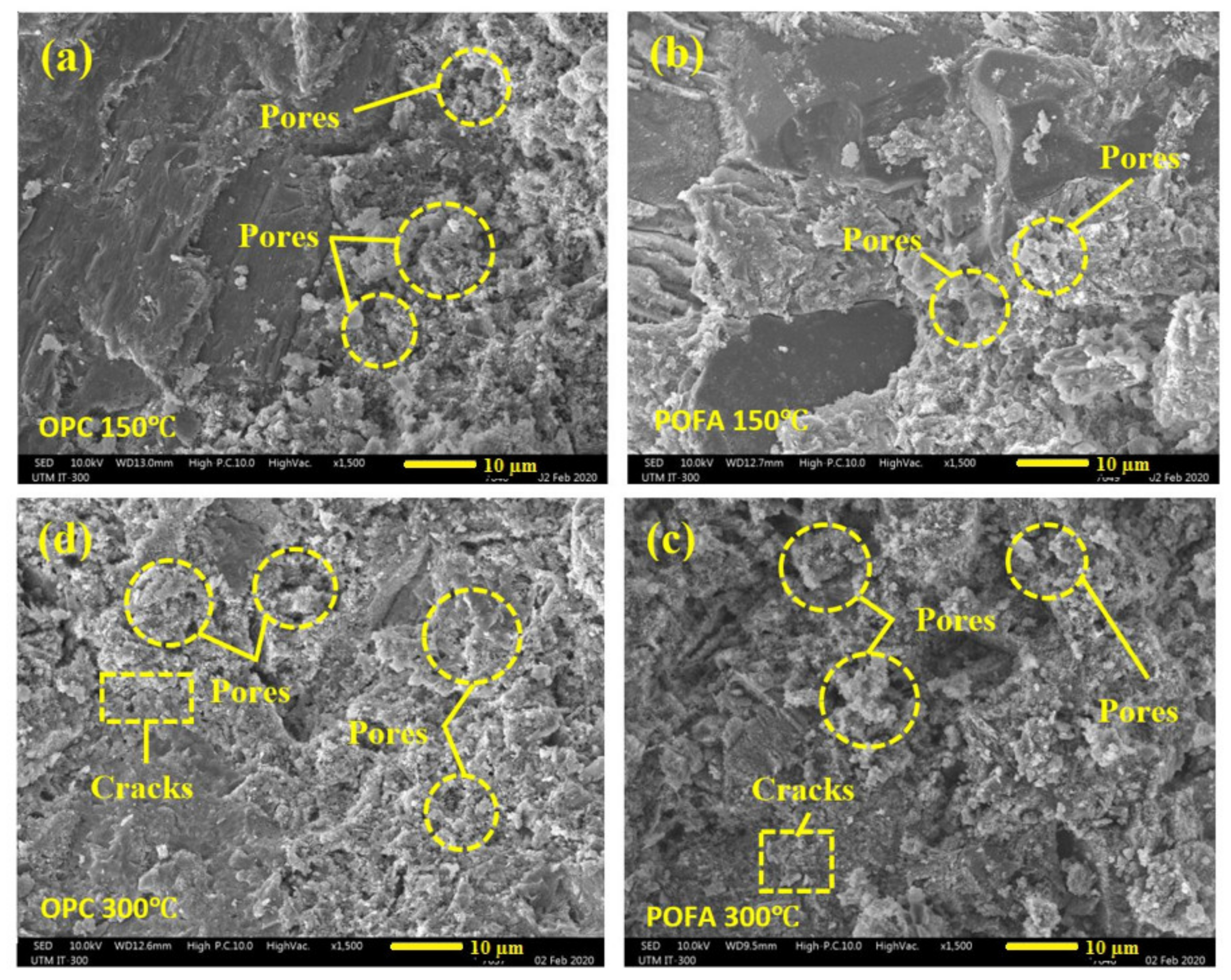


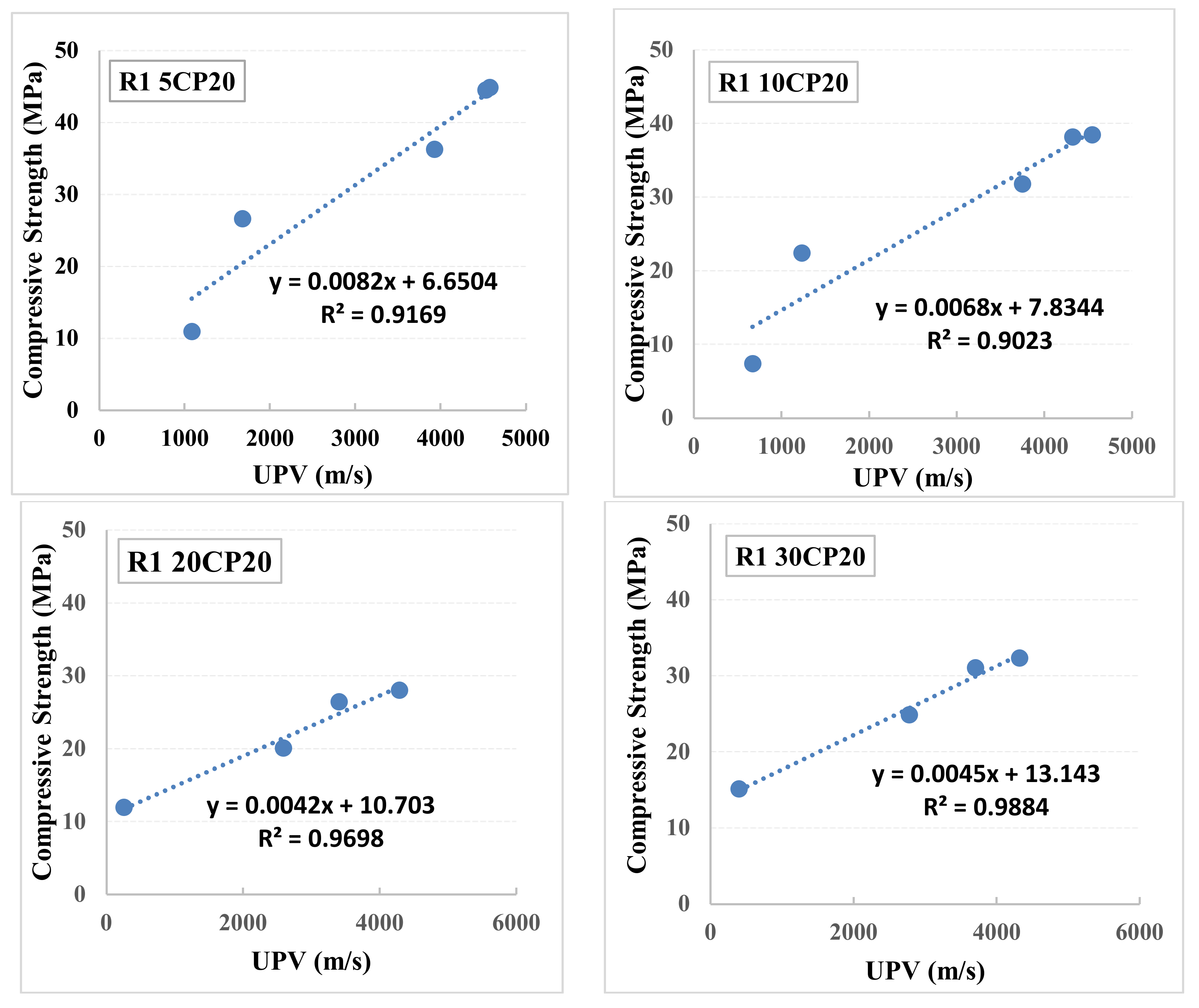
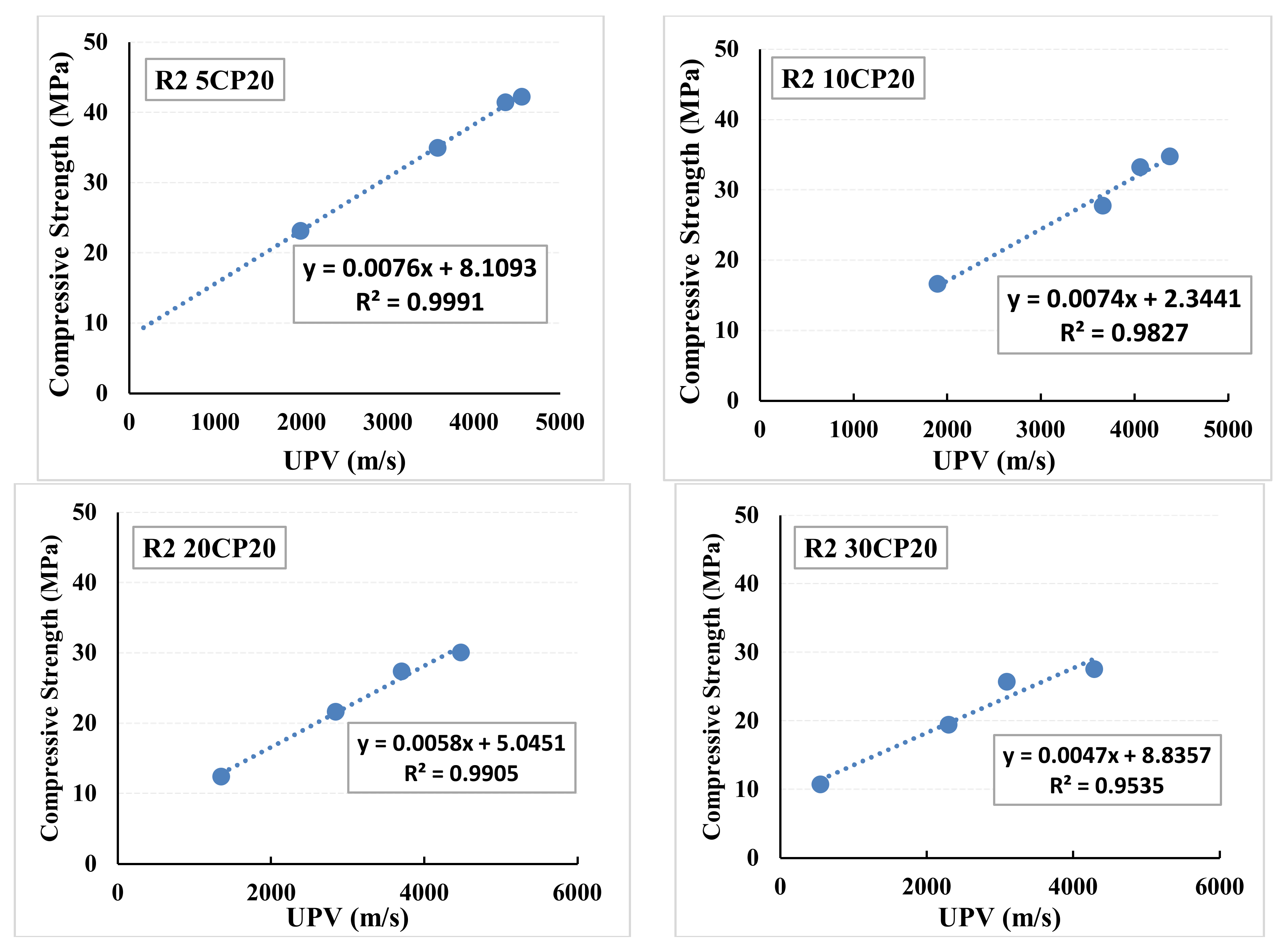

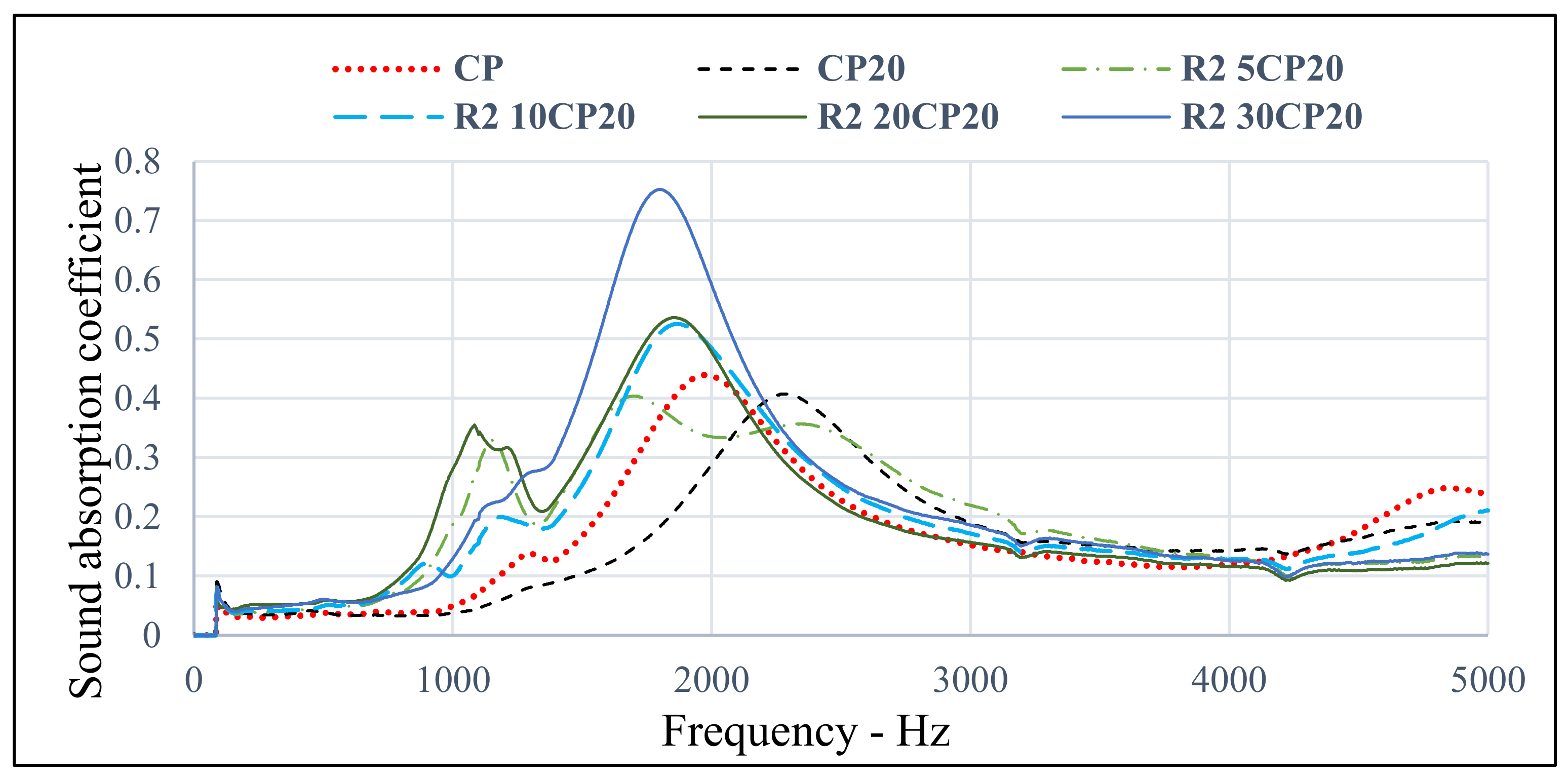

| Materials | Chemical Combination (mass %) | |||||||
| SO3 | SiO2 | Al2O3 | Fe2O3 | CaO | MgO | K2O | LOI | |
| OPC | 4.39 | 16.40 | 4.24 | 3.53 | 66.85 | 2.39 | 0.22 | 1.67 |
| POFA | 1.59 | 63.70 | 3.68 | 6.27 | 5.97 | 4.11 | 9.15 | 4.46 |
| Physical properties | ||||||||
| Specific gravity | Particle retained on 45 µm sieve | Specific surface (cm2/g) | Strength Activity Index (%) | |||||
| At 7 days | At 28 days | |||||||
| OPC | 3.15 | 4.58% | 5137.11 | - | 98.6 | |||
| POFA | 2.43 | 0.73% | 7796.17 | - | 103.4 | |||
| Specific Gravity | 1.210 at 25 °C |
| Color | Dark-brown liquid |
| Chloride Content | Chloride-free to BS 5075: Part 1 and 3 |
| Air Entrainment | Maximum 1% |
| Freezing Point | 0 °C—can be reconstituted if stirred after thawing |
| Mixes | Binder | Waste Tire Aggregates | Natural Aggregates | ||||
|---|---|---|---|---|---|---|---|
| OPC (kg/m3) | POFA (kg/m3) | Fine Fiber Rubber (kg/m3) | Fine Rubber (kg/m3) | Coarse Rubber (kg/m3) | River Sand (kg/m3) | Crushed Stone (kg/m3) | |
| CP | 450 | 0 | 0 | 0 | 0 | 782 | 874.5 |
| CP20 | 405 | 135 | 0 | 0 | 0 | 782 | 874.5 |
| R1 5CP20 | 405 | 135 | 13.17 | 0 | 0 | 742.8 | 874.5 |
| R1 10CP20 | 405 | 135 | 26.35 | 0 | 0 | 703.6 | 874.5 |
| R1 20CP20 | 405 | 135 | 52.68 | 0 | 0 | 625.25 | 874.5 |
| R1 30CP20 | 405 | 135 | 79 | 0 | 0 | 546.9 | 874.5 |
| R2 5CP20 | 405 | 135 | 0 | 19.85 | 0 | 742.8 | 874.5 |
| R2 10CP20 | 405 | 135 | 0 | 39.7 | 0 | 703.6 | 874.5 |
| R2 20CP20 | 405 | 135 | 0 | 79.4 | 0 | 625.25 | 874.5 |
| R2 30CP20 | 405 | 135 | 0 | 119.1 | 0 | 546.9 | 874.5 |
| R3 5CP20 | 405 | 135 | 0 | 0 | 22.23 | 782 | 830.77 |
| R3 10CP20 | 405 | 135 | 0 | 0 | 44.46 | 782 | 787.1 |
| R3 20CP20 | 405 | 135 | 0 | 0 | 88.93 | 782 | 699.6 |
| R3 30CP20 | 405 | 135 | 0 | 0 | 133.92 | 782 | 612.1 |
| Specimens | Velocity at 27 °C (m/s) | Velocity at 150 °C (m/s) | Velocity at 300 °C (m/s) | Velocity at 500 °C (m/s) | Velocity at 800 °C (m/s) |
|---|---|---|---|---|---|
| CP | 4796 | 4577 | 3815 | 1726 | 1127 |
| CP20 | 5070 | 4784 | 4074 | 1829 | 1197 |
| R1 5CP20 | 4635 | 4575 | 3712 | 1678 | 1082 |
| R1 10CP20 | 4542 | 4320 | 3153 | 1229 | 668 |
| R1 20CP20 | 4319 | 3703 | 2774 | 397 | - * |
| R1 30CP20 | 4288 | 3403 | 2588 | 252 | - * |
| R2 5CP20 | 4555 | 4365 | 3577 | 1988 | 791 |
| R2 10CP20 | 4376 | 4061 | 3660 | 1896 | - * |
| R2 20CP20 | 4474 | 3703 | 2839 | 1343 | - * |
| R2 30CP20 | 4291 | 3097 | 2300 | 549 | - * |
| R3 5CP20 | 4400 | 4251 | 3552 | 1702 | - * |
| R3 10CP20 | 4285 | 4022 | 2637 | 341 | - * |
| R3 20CP20 | 4230 | 3181 | 1857 | - * | - * |
| R3 30CP20 | 4040 | 2880 | 1234 | - * | - * |
Publisher’s Note: MDPI stays neutral with regard to jurisdictional claims in published maps and institutional affiliations. |
© 2022 by the authors. Licensee MDPI, Basel, Switzerland. This article is an open access article distributed under the terms and conditions of the Creative Commons Attribution (CC BY) license (https://creativecommons.org/licenses/by/4.0/).
Share and Cite
Mhaya, A.M.; Shahidan, S.; Zuki, S.S.M.; Huseien, G.F.; Azmi, M.A.M.; Ismail, M.; Mirza, J. Durability and Acoustic Performance of Rubberized Concrete Containing POFA as Cement Replacement. Sustainability 2022, 14, 15510. https://doi.org/10.3390/su142315510
Mhaya AM, Shahidan S, Zuki SSM, Huseien GF, Azmi MAM, Ismail M, Mirza J. Durability and Acoustic Performance of Rubberized Concrete Containing POFA as Cement Replacement. Sustainability. 2022; 14(23):15510. https://doi.org/10.3390/su142315510
Chicago/Turabian StyleMhaya, Akram M., Shahiron Shahidan, Sharifah Salwa Mohd Zuki, Ghasan Fahim Huseien, Mohamad Azim Mohammad Azmi, Mohammad Ismail, and Jahangir Mirza. 2022. "Durability and Acoustic Performance of Rubberized Concrete Containing POFA as Cement Replacement" Sustainability 14, no. 23: 15510. https://doi.org/10.3390/su142315510
APA StyleMhaya, A. M., Shahidan, S., Zuki, S. S. M., Huseien, G. F., Azmi, M. A. M., Ismail, M., & Mirza, J. (2022). Durability and Acoustic Performance of Rubberized Concrete Containing POFA as Cement Replacement. Sustainability, 14(23), 15510. https://doi.org/10.3390/su142315510







